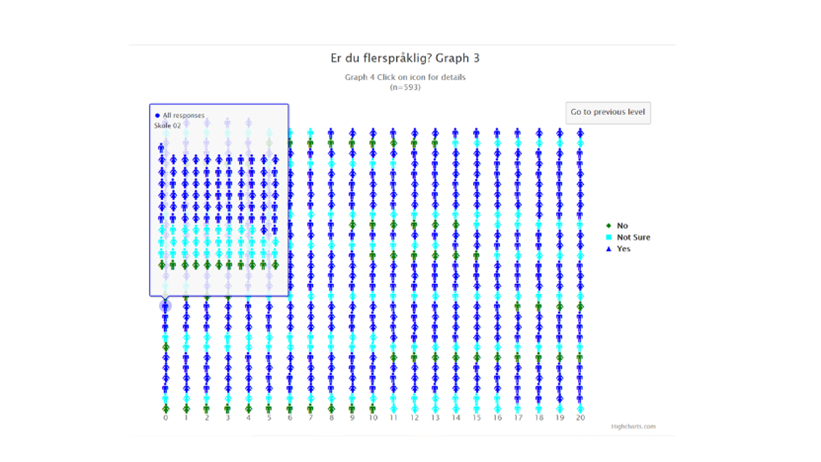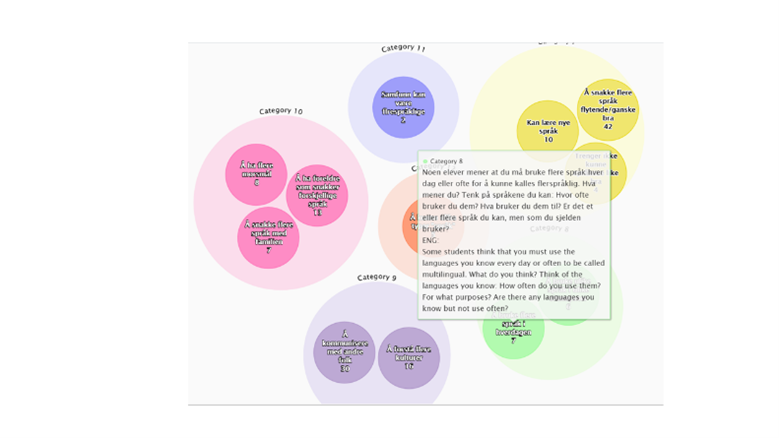What does it mean to be multilingual?
As Norwegian classrooms become increasingly linguistically and culturally diverse, this question gets more and more relevant to teachers and educators. Usually, definitions of multilingualism come from scholars and we hardly ever hear from pupils what THEY think it means to be multilingual.

Hovedinnhold
As Norwegian classrooms become increasingly linguistically and culturally diverse, the question "What does it mean to be multilingual?" gets more and more relevant to teachers and educators. Even though definitions of multilingualism abound, they usually come from scholars and we hardly ever hear from pupils what THEY think it means to be multilingual. To address this question, the Ungspråk research team developed data visualisations based on two questions taken from the Ungspråk online questionnaire, which was answered by 593 lower-secondary school pupils from 7 different schools in Bergen, between April and August, 2019. The visualisations were designed to promote discussions on multilingualism, encourage pupils to work with real research data and develop data literacy.
The visualisations were used for the first time in interactive sessions with pupils in one of the participant schools in December 2020. The interactive sessions are based on ethical principles of research dissemination that guarantee the right of participants to have access to, examine and question research data[1]. Together, the interactive sessions and the visuals represent an innovative and unique way to explore research findings with participants, make them benefit from research and broaden our understanding of what it means to be multilingual from the perspective of school children.
The first visual (Å være flerspråklig betyr…) was designed to raise students’ awareness about multilingualism based on their own definitions of the term. It consists of multi-layered activities in which students have the opportunity to “play researchers”, manipulating and exploring data and comparing their categorizations with those of the researchers. The visualisation also contains further questions for discussion, which explore different aspects of multilingualism - such as family languages, language proficiency, frequency and context of use, societal multilingualism, etc. - based on the categories the pupils generated.
Link to visual: https://org.uib.no/multilingual/Betyr/Betyr.html
English version: https://org.uib.no/multilingual/Engelsk/Betyr.html
The second set of visuals consists of four different graphs representing pupils answers to the question “Er du flerspråklig?”. They can be used to enhance the discussions and also as a tool for exploring different aspects of data literacy. Link to visual: https://org.uib.no/multilingual/ErDu/ErDu.html
To read more about the overall design of the Ungspråk research project and the development and validation of the Ungspråk online questionnaire, please refer to the articles below. The theoretical rationale underpinning the visualisations and the interactive sessions will be discussed in a forthcoming article, along with analyses of the data from the sessions.
- Haukås, Å., Storto, A. & Tiurikova, I. (2021). The Ungspråk project: Researching multilingualism and multilingual identity in lower secondary schools. Globe: A Journal of Language, Culture and Communication. 12: 83-98 ISSN: 2246-8838 https://doi.org/10.5278/ojs.globe.v12i.6500
- Haukås, Å., Storto, A. & Tiurikova, I. (forthcoming). Developing and Validating a Questionnaire on Young Learners' Multilingualism and Multilingual Identity. The Language Learning Journal. ISSN:1467-9922.
FOR MORE INFORMATION ABOUT THE VISUALS AND HOW TO EXPLORE THEM IN CLASSROOM ACTIVITIES, PLEASE CONTACT: andre.storto@uib.no
[1] See article 46 of the Guidelines for Research Ethics in the Social Sciences, Humanities, Law and Theology: www.forskningsetikk.no/en/guidelines/social-sciences-humanities-law-and-theology/guidelines-for-research-ethics-in-the-social-sciences-humanities-law-and-theology/

